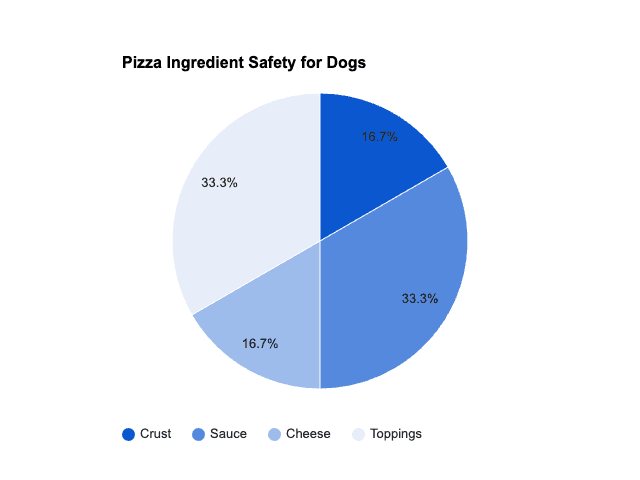Pizza – a cheesy, saucy, sometimes meaty delight that's irresistible to many of us. But as our dogs gaze longingly at our slices, the question arises: is it okay to share? Let's break down why regular pizza isn't ideal for dogs and explore safer alternatives.

Is Pizza Safe for Dogs?
The short answer is: it depends. While a tiny bite of plain crust might not cause immediate harm, most pizzas contain ingredients that can range from mildly upsetting to downright dangerous for our canine friends.
Why is Pizza Bad for Dogs?
Let's examine the most common pizza components:
Crust: Store-bought crusts often have high sugar and salt content, unhealthy for dogs. Homemade crusts with whole-wheat flour or cauliflower are better options.
Sauce: Tomatoes are generally okay in moderation, but pizza sauce frequently contains garlic and onion, both toxic to dogs.
Cheese: Some cheeses are high in fat, potentially causing stomach upset or pancreatitis in dogs. Others might contain molds harmful to sensitive pups. Small amounts of low-fat mozzarella are usually safe.1
Toppings: Plain-cooked chicken is fine, but processed meats like pepperoni are high in salt and unhealthy additives. Onions are always a no-go!
Other Pizza Dangers for Dogs
Excess Calories: Pizza is loaded with empty calories, which can contribute to canine obesity, a serious health problem2.
Salt Overload: Too much salt can lead to dehydration, high blood pressure, and even kidney issues in dogs.
Greasy Overload: Excess grease can trigger vomiting, diarrhea, and potentially pancreatitis, a painful inflammation of the pancreas3.
My Dog Ate Pizza – What Now?
Assess: Note the amount and type of pizza they ate. Did it contain garlic, onion, or other harmful toppings?
Monitor: Watch for vomiting, diarrhea, lethargy, or unusual behavior.
Contact Vet: Call your veterinarian immediately, especially if they ate a large amount or toppings known to be toxic.
Did You Know?
Garlic and Onion Toxicity
As little as 15g of garlic per kilogram of a dog's body weight can lead to harmful changes in their blood.4
*Research studies found through PubMed & veterinary articles on sites like VCA Hospitals.
Salt Overload
One slice of pepperoni pizza can contain over 300% of a dog's daily recommended sodium intake.
*Compare nutritional charts for pizza vs. the American Association of Feed Control Officials (AAFCO) recommended daily values.
Pancreatitis Risk
Dogs eating fatty foods have a 33-66% greater risk of developing pancreatitis compared to those on low-fat diets.
*Veterinary studies exploring the link between diet and pancreatitis on PubMed

*Disclaimer: Data represented is for illustrative purposes only. Sources: ASPCA, VCA Hospitals
Expert Insights From Spot
While it can be fun to share our favorite foods with our pets, pet parents should keep in mind that sometimes, eating human food can upset a pet's stomach. Spot's internal data shows that on average, claims for dietary indiscretions (pets eating too much of what they shouldn't) cost $572.* This high cost highlights why pet parents should keep an eye on what their pets eat, and do their research before sharing their favorite snacks with their dogs. Being mindful of what treats we share with our pets can help keep them healthy while helping pet parents avoid unnecessary vet bills.
Safe and Healthy Snacks for Your Dog
While most store-bought or delivery pizzas pose potential dangers for dogs, you can make them a delicious and nutritious pizza-inspired treat! Consider these dog-friendly ingredients:
Fruits: Berries (blueberries, strawberries, raspberries), melons, apples (without core or seeds), cherries (without pits), and bananas.
Veggies: Green beans, kale, broccoli, carrots, sweet potatoes (cooked for easier digestion).
Proteins: Cooked, unseasoned chicken, plain cooked fish (shrimp, tuna, salmon), eggs.
Other Options: Plain, low-fat yogurt as a "sauce" substitute, a small amount of peanut butter (unsalted, xylitol-free).
Important Notes:
Moderation: Even healthy treats should be given in small amounts.
Preparation: Always remove pits, seeds, and stems from fruits. Cook vegetables and proteins thoroughly.
Allergies: Be aware of any food sensitivities your dog may have.
Help Protect Your Pet and Your Budget with Spot Pet Insurance
Spot Pet Insurance understands that unexpected vet bills can be stressful. That’s why our plans offer customizable coverage with flexible options to fit your needs and budget. Choose your own annual limit and reimbursement rate (up to 90%), and enjoy the peace of mind that comes with no per-incident or lifetime caps. Spot plans help cover unexpected accidents and illnesses, and you can even add preventative care to help keep your furry friend healthy with coverage for routine exams, vaccines, dental cleaning, and more. Get a free quote today!

The resident animal enthusiast at Spot. I have a lifetime of pet parent experience. If it has fur, feathers, or scales, I’ve probably shared my home with it. I aim to be a reliable source, blending experience with a dedication to the well-being of pets.
*Jan 2019 to Aug 2024 Spot Pet Insurance Services, LLC claims data.
“Can Dogs Eat Cheese?" Purina, 27 Mar. 2025, www.purina.co.uk/articles/dogs/feeding/what-dogs-eat/can-dogs-eat-cheese, n.d.
Williams, Krista, et. al., “Obesity in Dogs.” VCA Animal Hospitals, n.d., vcahospitals.com/know-your-pet/obesity-in-dogs.
Hunter, Tammy, et. al., “Pancreatitis in Dogs." VCA Animal Hospitals, n.d., vcahospitals.com/know-your-pet/pancreatitis-in-dogs.
Kubala, Jillian. "Is Pizza Healthy? Nutrition Tips for Pizza Lovers." Healthline, 29 Jun. 2023, https://www.healthline.com/nutrition/is-pizza-healthy.
The information presented in this article is for educational and informational purposes only and does not constitute or substitute for the advice of your veterinarian.












